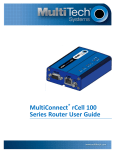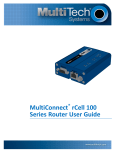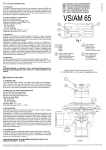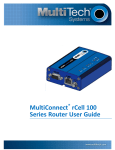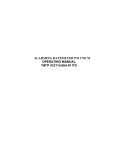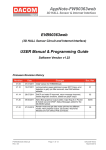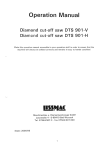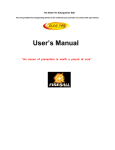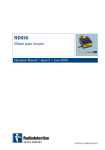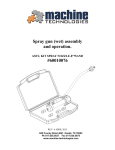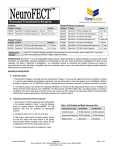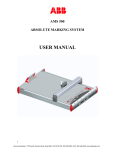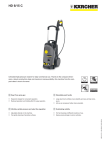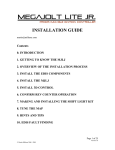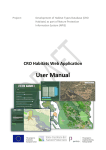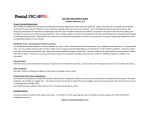Download USER MANUAL/GUIDELINES
Transcript
Content of the CATCO®-pac: The CATCO®-pac includes the following items: a. 4 pcs 25 liter cans of CYTOCLEAN® b. 1 pc Air-driven Diaphragm-pump with GEKA connections on suction and pressure side c. 1 pc Suction-hose, size ¾ “ with a length of 3 meters and GEKA connections d. 1 pc Pressure hose, size ¾ “ with a length of 10 meters and GEKA connections e. 1 pc Adjustable nozzle, with GEKA connections USER MANUAL/GUIDELINES Put the separate item correct together and secure the connections of the hoses if possible by tape, in order to avoid unintended disconnecting and to prevent leakage. A. Equipment Set-up and Preparation a. Put the CYTOCLEAN® can as close as possible to the surface to be cleaned. b. Fix the flexible delivered suction-hose securely at the opening of the can, so the pump can easily defuel the can. c. Connect on the other side of the suction hose securely to the section side of the pump. d. Now fix one side of the pressure hose to the pressure side of the pump and connect the nozzle to the other side. e. Now connect the pump to the air pressure. f. Please be reminded that the pump requires at least 5 bar air pressure for smooth operation. B. Cleaning Operation a. Spray the contaminated area spacious with CYTOCLEAN®. Make sure also any areas that are difficult to reach/access are sprayed. b. When spraying the CYTOCLEAN®, the nozzle used should be adjusted in a wide angle. c. CYTOCLEAN® has to be used neat, because it is not water-dillutable. d. After spraying, allow 60 minutes for CYTOCLEAN® to impact, react, coat the oil and isolate it from the surface. e. In case of older contamination, please be reminded that it might take longer time. FATE’s Global Partner in Cleaning Solution f. Generally, once the reaction and movement of the oil is visible, the washing process can commence. C. Washing Process a. Washing is done with the same equipment than spraying. Connect the hoses to the water-system and start washing. b. Please be reminded, that for washing, more air and water pressure is required. In this case, adjust the nozzle to a tight angle in order increase the pressure as much as possible. c. In case of heavy and/or older contamination, the use of a high-jet cleaner might be an recommended for usage to get the better result. D. Disposal a. While separation of oil and water is essential, please be reminded to collect a sample of the mixture in a transparent bin, to observe the separation, before discharging the water. b. If no separation required, the mixture should be collected at the lowest point of the cleaned area and be transferred by diaphragm-pump to bilge/sludge tank. c. If only oil stains have to be cleaned, CYTOCLEAN® should be used by rags. Just soak the rag and map the oil-stains easily. The surface will clean and dry within a few minutes. d. Clean all the equipment used in the process thoroughly with water, to preserve its condition and for the following usage. CYTOCLEAN® is non-toxic product, thus no specific safety and protection equipment is required. However, we recommend all operators to wear Boiler-Suits, Safety Shoes, Gloves and Safety Hats. Kindly refer to the product’s MSDS for details. FATE’s Global Partner in Cleaning Solution CYTOCLEAN® Material Safety Data Sheet (MSDS) in accordance with EC Directive 91/155/EEC Product and Producer/Origin Product name : CYTOCLEAN® Bio-solvent Producer/Origin : GLOBAL - CONCEPT GmbH Gustav-Heinemann - Strasse 22, 26919 Brake / Germany All enquiries to : Tel.: +49 4401 704090 Fax: +49 4401 704092 Emergency information: Contact National emergency call number or NPIS via a physician Composition, Information on Ingredients Chemical characterization: Vegetable oil methyl ester with additives, CAS-No.: 73891-99-3 Hazard Identification Not classified. No currently known hazards. Use according to technical data sheet. First-Aid Measures If handled with due care and according to manufacturer’s application guidelines no special measures are required. In some cases minor effects on health may be expected. Please adopt the following measures: In case of inhalation: Non-irritating or toxic, however in case of affliction please remove to fresh air as a precaution. In case of skin contact: May in some cases of high sensitivity cause mild irritation. If afflicted, please wash contact area with soap and water. In case of eye contact: If irritation occurs, lift eyelid and flush eye immediately with cool fresh water for a t least 10 Minutes. Do not rub the affected eye! If irritation persists, or any sign of tissue damage is apparent, consult a physician. In case of ingestion: Generally not toxic, but as a precaution swill mouth generously with water. Do not induce vomiting. If ingested in conjunction with alcohol or medicines, seek medical advice immediately. Fire-fighting Measures Extinguishing media: Foam, dry chemical powder, CO², sand or earth. Measures to be avoided: Do not spray water directly on flames. FATE’s Global Partner in Cleaning Solution Special hazards: Flammable. In case of fire, toxic gases or vapors as well as CO and CO2 may be formed. Special firefighting equipment: Wear suitable protective clothing. Self-contained breathing apparatus is necessary in the danger area if ventilation is poor. Accidental Release Measures Personal safety precautions: Avoid prolonged eye or skin contact. Environmental precautions: Although biodegradable, please prevent spillage into public drainage or local water systems. Prevent further spreading by using sand, earth or other suitable barriers. General Precautions: Prevent open fire. Methods for cleaning/removal: In case of excessive spillage bind material with suitable absorbent substrate. Dispose to an approved waste disposal site, observing all local and national regulations. Handling and Storage Handling: Avoid prolonged eye or skin contact. Keep away from open fires. Observe general regulations for handling of chemicals. Storage: Store in dry containers in well ventilated surroundings. Keep containers closed and prevent exposure to direct sunlight and heat sources. Avoid contact with strong oxidizing agents. Storage classification: VCI - Classification 10 Exposure Control, Personal Protection Occupational Exposure to Product: No specific exposure time limitation. Specific equipment required in handling: No special equipment required. Inhalation protection: No special equipment required. Eye protection: Generally not required, but advisable when transferring product between storage containers. Skin protection: Wearing of protective gloves is advised in cases of prolonged contact. General Precautions: Observe general regulations for handling of chemicals. Physical and Chemical Properties Form : Liquid Color : Light green to amber Odor : Weak characteristic odor. Freezing point : Approx. -20°C Ignition point : Not known. Flash point : 180 °C according to DIN 51758 / ISO 2719 Explosion point : Not known. Boiling point : Approx. 300 °C Cloud point : -8 °C Pour point : -10 °C Specific density(20°C) : 0.875 – 0.885 kg/l Solubility (20°C) : Insoluble in water. Kinematic viscosity (40°C) : 4.0 mm²/s DIN 51562 Kinematic viscosity (100°C) : 1.7 mm²/s DIN 51562 FATE’s Global Partner in Cleaning Solution Stability and Reactivity Stability: Stable if handled within guidelines and usual good practice. Special situations to be avoided: None, if handled within guidelines and usual good practice. Materials to avoid: Avoid contact with strong acids, bases or oxidizing agents. Hazardous decomposition products: None, if handled within guidelines and usual good practice. Toxicological Information Toxicity: LD50 (oral, rat) > 2000 mg/kg body weight. Toxicological Data: Inhalation: May cause headache and dizziness if handled inappropriately. Eye irritation: Non irritating (Rabbit, OECD-Method 405) Skin sensitization: None known. Skin irritation: Non irritating (Rabbit, OECD-Method 404) General remarks: Prolonged and intensive exposure to the skin may cause degreasing, dry skin and in the case of extremely sensitive persons lead to dermatitis. Ecological information Information for all components: Aquatic toxicity: Fish toxicity: Acute, LC50 > 100 mg/l Bacteria toxicity: Acute, EC50 > 100 mg/l Biotic degradation: Product components are classed easily biodegradable (OECD A-F test results at least 60% BSB/CSB or 70% DOC degradability within 28 days). Half-life time biodegradation in seawater is expected within 4 days (EPA standard biodegradation assessment), with bio-degradation to water and CO2 components completed within 28 days. Disposal Information Comply with local regulation for waste disposal to an approved waste disposal site, observing all local and national regulations. Spent or unused remnants of the product are not to be disposed of via the sewerage system. Consign empty container to normal waste. Transport Information Non-dangerous or hazardous cargo (in accordance with RID/ADR, GVS/GGVE, ADNR, IMDG, ICAOTI/IATA-DGR). FATE’s Global Partner in Cleaning Solution Regulatory Information Classification and labeling in accordance with EC regulations for dangerous and hazardous cargos: Labeling: Not necessary Risk phrases: N/A Safety phrases: N/A Water pollution class: WGK 1 Additional Information The above information is based on the present state of our knowledge of the product at the time of publication. The information is given in good faith; no warranty is implied with respect to the quality or the specification of the product. The product is of natural origin and may vary in its properties within given tolerances. The user must satisfy that the product is entirely suitable for the purpose. The information contained in this safety data sheet does not in itself constitute a workplace risk assessment as may be required to be carried out under COSHH Regulations. FATE’s Global Partner in Cleaning Solution CYTOCLEAN® Technical Data Sheet (TDS) / Application Guidelines -1General Information CYTOCLEAN® is suitable for use on all types of mineral oils (Class 1–4, i.e. Diesel to Bunker C). For further product details, measures to be taken in an emergency and other safety relevant measures please consult the material safety data sheet. In case of any doubt or question in specific handling, please do not hesitate to contact us. On-Site Application CYTOCLEAN® is suitable for use on the following: 1. Shores and Landscape Coarse sandy beaches, where petroleum has penetrated into sand Rock and pebble beaches, where contaminant has penetrated sand and covered rocks and pebbles with film. Rocky shores and tidal zones, where oil has become trapped in sea water pockets. Sea marshes, marshy areas and vegetated Wetlands, where oil has coated plants and become trapped. Fisheries, hatcheries, river banks and other sensitive or high impact sites Arable soil, contaminated with heavy oils. Sea walls, tidal breakers, pilings, inland canal locks and sluices where accidental spillage of heavy oils may occur. 2. On-Shore Tanks Diesel or Crude oil tanks in refineries, where oil/solid residues need to be removed and recycled. 3. Off-Shore Tanks Ballast tanks in shipping (surface) or submarine, where decontamination of water can be reversed. Bilges, where decontaminants seep in over a period of time. Storage tanks on tankers (residue recycling). Tanks on offshore drilling platforms. The CYTOCLEAN® – Procedure has been successfully field tested in many such situations. For references please apply to the named contact address. -2– FATE’s Global Partner in Cleaning Solution Recommended methods of application: Application is to be carried out by trained personnel only. Soiled surfaces (tank walls or rock) are to be spray treated with low pressure applicator. Substrates such as soils can be taken up and mixed with CYTOCLEAN®, for example in mobile concrete mixers. Tank residues can be mixed with CYTOCLEAN® in the vessel. After reaction period of at least 1 hour, oil / CYTOCLEAN® or oil / substrate mixture / CYTOCLEAN® can be washed off with water. Mechanical separation of organic (CYTOCLEAN® / oil) and anorganic (water / suspended particles) phases is not required. The CYTOCLEAN® – process is most suitable for the treatment of heavily oiled-shorelines that do not respond well to conventional treatments or are considered too sensitive for mechanical / pressure wash strategies. CYTOCLEAN® is applied to oiled shorelines to extract and recover weathered petroleum by flotation with passive water deluges from header pipes or manual spraying. Should surplus CYTOCLEAN® remain in the water, then this is biodegraded. Prior to the application of CYTOCLEAN®, collection booms, oil skimmers, sorbent pads, or other appropriate containment and collection mechanisms must be deployed and operational. Concentration / Application Rate: CYTOCLEAN® is to be used only neat and undiluted, for direct application to spilled oil. CYTOCLEAN® may be applied with a variety of spraying or washing equipment, depending upon the scale and type of the shoreline to be cleaned. For large beach areas, CYTOCLEAN® can be sprayed from water trucks or work boats equipped with pumps, hoses and nozzles to deliver CYTOCLEAN® as an aerial spray. In smaller applications, CYTOCLEAN® may be applied with hand sprayers or portable pumps to spray CYTOCLEAN® directly onto oiled surfaces. -3Dose rates will vary with the type and amount of oil-spilled, the extent of weathering, and other site specific conditions, including temperature, porosity of shoreline, and residence time available to let CYTOCLEAN® contact the oil. In general, the ratio of applied CYTOCLEAN® to crude-oil is between 1:5 and 1:1 (parts CYTOCLEAN® to oil by volume). FATE’s Global Partner in Cleaning Solution The quantity of CYTOCLEAN® applied should be approximately equivalent to the quantity of petroleum accumulated on the shoreline, or as required to dissolve and remove weathered oil. After application, CYTOCLEAN® should be allowed to penetrate and dissolve the weathered oil for at least 1 hour, preferably longer. Cold weather applications will require more contact time before initiating recovery. In tidal areas, it is advisable to apply CYTOCLEAN® as the tide is ebbing (receding) to maximize contact time. Trapped oil may continue for several days, requiring that containment devices be left in place. Shelf Life / Storage Shelf Life: When stored in closed container in a dry environment, the shelf-life of CYTOCLEAN® is minimum of 10 years. When stored in open containers and in a warm, humid environment, the shelf-life of CYTOCLEAN® will decrease to 1 year. CYTOCLEAN® does not deteriorate appreciably over time, but will grow bacteria if water condensation accumulates in the container. Storage: CYTOCLEAN® should be stored in airtight containers, if possible, without excessive exposure to moisture, at temperatures between 4°C (39°F) and 44°C (110°F). Avoid direct sun, exposure to UV radiation and freezing. At temperatures below cloud point 6°C (43°F), CYTOCLEAN® may become cloudy, but will return to normal upon warming, with no effect on performance. FATE’s Global Partner in Cleaning Solution









